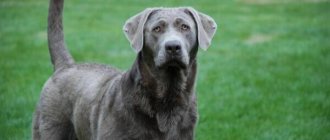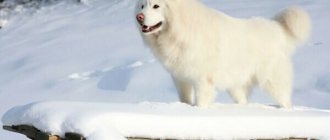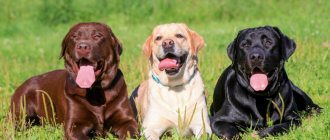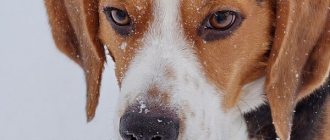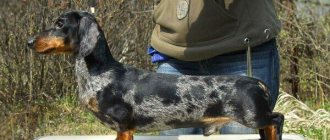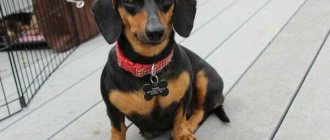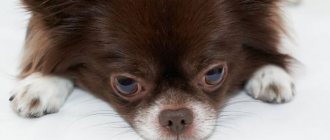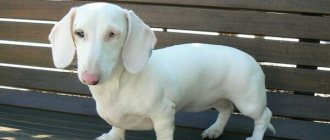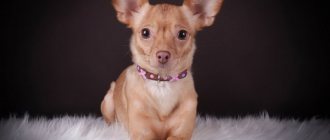Labradors are one of the most favorite breeds among married couples, especially if there are children in the family.
They are known for their loyalty to their owners, kind attitude, they make wonderful companions for people and are great with children.
They are also recommended by dog handlers as companions for the disabled and the elderly.
This breed has also been noticed by law enforcement agencies and is often used for police work.
Due to the fact that the Labrador is highly trainable, with the right approach, it can become a faithful companion for a person.
History of appearance
The question of the appearance of the first Labradors still remains open; presumably the ancestors of the breed are Newfoundlands, which appeared in the late 1700s.
They were also called St. John's water dogs.
Such an unusual breed was considered a legend - the dog had webbed feet that helped in swimming, was not afraid of the cold, easily dived into icy water and helped fishermen when catching fish. In the early 1800s, the British Earl of Malmesbury brought St. John's dogs to England for breeding.
The breed so impressed the count with its abilities that he began to use it for hunting competitions..
The count gave this breed the name Labrador; it is believed that he borrowed it from the island of the same name, but there is no exact information on this matter.
In 1903, the British Kennel Club recognized Labradors as a separate breed. But in America, Labradors were recognized only in 1917. In 1920-1930. Fawn Labradors are the most popular.
Now fawn Labradors are actively used in the fight against drug dealers, at airports and for work in the Ministry of Emergency Situations. This breed is also trained to accompany the blind.
To become a guide dog, it needs professional training, otherwise not only the disabled person, but also the dog will suffer.
An example of the use of fawn color in painting
Quite a few masterpieces of painting contain this mysterious tone. Thus, the color fawn is often found in the works of Renaissance authors, in particular, it can be seen in the paintings of Leonardo la Vinci, Raphael, Bellini. To depict the skin of their Madonnas, and also wanting to emphasize the insignificance of everything that happened in the background, artists used this particular color in any of its varieties. A fawn tone is often found in the works of realist artists, including Savrasov, Repin and others. This warm and restrained color can also be found in some Impressionist works.
What does it look like in the photo?
The fawn color gives the Labrador breed an aristocratic appearance and looks very noble.
The breed has its own standards for external characteristics , which are approved by the International Canine Federation :
- large wedge-shaped head with an elongated muzzle;
- the muzzle is large, the nostrils are widened;
- cheeks are taut and have no folds;
- the nose is straight and even, tapering towards the tip;
- the bite is correct, the teeth are even and tightly adjacent to each other;
- eyes are set wide apart, usually brown;
- the neck is strong; back straight; the loin is short and strong; the chest is wide and deep;
- the paws are round in shape and have leathery membranes;
- the ears are triangular in shape, hanging, located slightly behind the muzzle;
- thick tail at the base, tapering slightly towards the tip;
- horizontal tail orientation;
- dense coat with undercoat, sticky to the touch due to lubricant to ensure water resistance;
- has a creamy coat, sometimes there may be a predominance of red.
Names of dog colors
Harlequin
- aka marble color. A striking example is the marbled Great Dane or Dalmatian.
Fawn color
– all shades of sandy color, the mask on the face is dark, there is often a white shirtfront on the chest extending onto the stomach and paws.
Black color
– rarely found completely black, without blotches. There may be individual multi-colored spots (white, red, brown).
White color
– Albinos are not found among dogs. Snow-white coat (spots allowed), black nose, brown or blue eyes. Handsome guys, they just get really dirty.
Brown color
– color gradation from chocolate to brown (brown with black).
Red color
- sunny dogs. All shades of red can be present on the skin, from light apricot to brown-red.
Golden-red color
. The difference from the previous one is that the tip of the hair has a rich red-red tint, almost fox-like, and on the muzzle there is a dark mask, sometimes black.
Black color
. Cheprak (chaprak) is a warm bedding for a horse saddle. Black-and-white is a dog's two-color coloration. These dogs have a darker color on the back, brown or black). The size of the blanket can only extend across the back, or maybe extend over the hind legs and part of the tail. There is a dark mask on the muzzle. Cheekbones, chest, stomach and legs can be light. This was our Bonchik, and so was Asta.
Wolf color
. The hair has different colors along the length, dark at the tip, very light at the root and something in between the colors in the middle part. There may be a dark belt-like stripe along the ridge.
Deer color
. On the chest it is lighter, the main color is yellow-brown-red. This dog is somewhat reminiscent of a fawn.
Bambi from the Polyanka Shelter. Waiting for the Master!
Pepper and salt
. The name speaks for itself. The hairs of the coat are unevenly colored, with alternating light and dark zones in black and gray tones.
Piebald color
. Pejins are large white spots with an uneven outline on a dog’s skin. That is, the dog is black, and there are gray spots on its skin, merging in places, so that it looks like a gray dog with black spots. An example of this color is the Russian spaniel.
Murugy color
. Dark red with a white bib. Hair tip – black-brown
Marble color
. On a light background, spots of different sizes are scattered across the skin. Color of spots: gray, brown, red, black. Hello, Lerchik! We have determined your suit.
Our Lerchik is on duty)
White mask
. The dog is dark and the mask on its face is white. An example is the Alaskan Malamute.
Roan color
. It looks like a variegated skin, with freckles sitting densely against a light background. Color red and silver. An example is the shorthaired pointer.
Brindle color
. The name speaks for itself. The dark ring stripes should close together. The main color scheme is brownish-red. A white shirt and socks are acceptable. Most often there is a dark mask on the face.
Tan color.
Multi-colored Spitz dogs are an example of this. Tan marks are lighter spots that contrast with the base color. Can be located on the face, chest, paws.
Solid color.
Without inclusions, areas of a slightly lighter shade are possible.
Gorgeous dog - Genghis Khan in search of a Home (Polyanka Shelter)
Here's the information. It is interesting that veterinary passports do not particularly elaborate on determining the color of a dog. We simply have it written down: three-color.
Dogs of the French Bulldog
They are miniature in size, but retain all the advantages of their large fighting brothers. They are distinguished by high intelligence, good disposition and intelligence, and are unpretentious in their care. An excellent option for owners with small living space and children. Competent and timely training makes them obedient dogs, capable of following any commands and protecting the owner’s family in the event of a threat. The article will discuss the main characteristics of the breed, care rules and popular nicknames. After reading, the reader will easily decide whether to get a French bulldog.
Marriage or breed?
Despite the nobility of the fawn shade, its inherent aristocracy and beauty, this shade was not a color standard for a long time.
Initially, until 1924, the fawn shade was considered a defect, then the only true color was considered to be black labradorite. But over time, the fawn shade gained more and more popularity among dog breeders.
Labrador Dudleys with impaired pigmentation are considered to be a deviation from the standard fawn shade.
Currently, many breeders of this breed breed fawn Labradors.
Expert opinion
Kozhevin Semyon Kirillovich
Expert dog handler.
“For healthy dogs, it is best to contact specialized nurseries, where they will select a suitable puppy for you. It is better to choose a kennel of the Russian Canine Federation. Labradors are distinguished by the fact that they can adapt to new people at any age. If the owner suddenly twists his leg while hunting, the dog will calmly go with another person. Aggression among Labradors is practically excluded, but owners must also exclude aggression in themselves. The dog is highly trainable from an early age. You need to control the game with children, despite their good nature, they can knock over a small child due to inexperience.”
Marbled Chihuahuas are prohibited!
Marbled Chihuahuas are prohibited!
The unusual color of the Merle Chihuahua attracts attention and arouses the interest of others. And it’s not surprising, because something new and unusual always fascinates and intrigues. Out of ignorance, many people want an amazing pet, which is what unscrupulous breeders take advantage of.
Be aware that when you buy a marbled puppy, you are getting a bunch of diseases in a beautiful furry shell. External attractiveness hides a number of serious problems that you will have to deal with personally.
Origin of the Merle Chihuahua
For the first time, people started talking about the unusual color just a few years ago in American nurseries. Despite the huge number of colors of Chihuahuas, the marble color of the coat has never stood on the same level with them.
According to geneticists, merle is an artificially bred coat color. Most likely, this result was made possible by crossing a Chihuahua with a Dachshund or Sheltie.
Demand creates supply. That is why there are many options on the Internet where the “presence” of another breed is observed in your beloved kids. Sheltie-like puppies are most commonly observed.
It is difficult to predict where and when the merle color will appear. One litter may have exclusively motley puppies, while another may have only one spot on their face. Moreover, motley parents may not produce brightly colored offspring and, conversely, non-motley dogs are capable of producing unusually spotted puppies.
There is no specific “system” that can predict future offspring. Currently, the most respected geneticists are studying the merle gene in order to subsequently produce absolutely healthy puppies.
Unfortunately, there are too few such conscientious breeders. Numerous nurseries, pet stores, and the Internet are unlikely to be able to please you with a healthy four-legged friend, because their main task is to make a profit. And the path doesn't matter.
The merle gene is predominant, and it is this gene that contributes to a number of health problems in future caudate offspring:
It's scary to imagine what the consequences will be when crossing two Merle Chihuahuas. The bred pet will be called a double merle. And, basically, the puppy is born completely deaf, has almost pale, colorless or unnaturally blue eyes. There is a lot of white on the coat, especially in the area of the head and ears, which is not natural for a Chihuahua.
Have you noticed similar features? Watch out! And under no circumstances buy such a puppy!
Chihuahua merle in Russia
It is no longer a secret that in many countries around the world, kennel clubs have recognized the “marble” gene as infinitely dangerous for Chihuahuas. A strict ban on registration of the merle color has been introduced in Australia and New Zealand. Color is a disqualifying feature in Canada and the UK. In Germany there is a strict ban on breeding and participating in exhibitions of Merle Chihuahuas.
But what about the situation with “marbled” dogs in Russia?
The Russian Federation, like other countries that are members of the FCI (international canine organization), recognized the merle color as unsafe and banned such individuals from breeding and selling. Accordingly, participation in exhibitions is strictly prohibited.
Please note that puppies born from Chihuahuas are merle and bred after 1.01. 10 years old, excerpts from the All-Russian Unified Pedigree Book are issued, where the stamp “color is not recognized by the FIC” and “is not subject to breeding” is affixed.
Fortunately for lovers of funny Chihuahuas, the breed pleases with a wide variety of colors (about 300 shades). Choose a healthy and strong furry family member, and leave the spotted color for other dogs, for whom it suits and does not cause harm to their health!
No other breed has such a wealth of colors as the Chihuahua! Among them there are both more or less common and quite rare. There is only one “banned” one. According to the breed standard, Chihuahuas are allowed one-color or two-color colors, as well as tricolor. Each color must correspond to certain colors of the nose and eyes. Most colors can be either long-haired or smooth-haired.
Character traits
The main character traits of Labradors:
- love, kindness, intelligence, loyalty to the owner;
- quick adaptation to people;
- this dog is a companion, it always needs company, otherwise it gets bored, which leads to apathy, depression and mischief;
- love active games, for example with Frisbee;
- they need mobility and long walks, they feel better in cottages;
- get along well with children and are tolerant;
Your dog needs training, even if it seems to obey you.
Harmonious combinations
Almost any element of a woman's wardrobe is decorated in fawn color - comfortable trousers, elegant skirts, fashionable shirts, romantic dresses and sundresses, sophisticated jackets and much more. Decorations and various accessory accents look extraordinary and interesting in this color design. But you can use more than one of them. For example, a great solution is to wear a set consisting of earrings, a necklace and a ring of this color design.
Outerwear - a trench coat, a fitted coat or a leather jacket - also looks amazing in fawn color. Since this shade is classified as a natural shade, images using it look very natural and naturalistic. Fawn items fit amazingly into tandems with brown, pastel and snow-white companions. The last option will give any young lady an innocent and touching look.
Source
Advantages and disadvantages
pros:
- love children, adore members of the household, are loyal to the owner, not aggressive;
- are smart, have a developed mind;
- excellent sense of smell;
- suitable for search work;
- easy to learn with the right approach;
- excellent hunters;
- are not afraid of water and heights;
- unpretentious;
- is an excellent guide and companion for older people.
Minuses:
The Labrador sheds actively, especially in the off-season, since the dog is large and has a lot of hair. A Labrador can ruin furniture, chew wires, eat something from the trash, or profit from gifts from the owner’s table. You should only walk your dog on a leash if the walk is planned in public places.
Being affectionate towards strangers can frighten other people and their children. If you are a busy person, then it is better to get a different breed; the animal will not forgive you for a long absence. He will be mischievous and may get sick.
Unusual shades
There are rare colors that are unique to some breeds. Blenheim is a rich chestnut color stain. They are arranged on a base of pearly white color. The color is found only in the Cavalier King Charles Spaniel. There should be a white diamond on the parietal part, and a chestnut-colored spot in the central part.
Merle is an uneven coat color. Appears in dark or light tones of the same color. This color is found in pit bulls.
Dimensions, weight and other distinctive features of fawn Labradors
| Puppy age | Weight, kg | Height at withers, cm. | Chest circumference, cm. | Head circumference, cm. |
| 1 month | 3,4-3,8 | 23-23,5 | 37-38 | 27-28 |
| 2 months | 7-8 | 30-32,5 | 45-46 | 29-32,5 |
| 3 months | 12-14 | 39,5-42 | 51-56 | 34-36 |
| 4 months | 17-19 | 44-46 | 60-64 | 38-39 |
| 5 months | 21-22 | 48-51 | 66-68 | 41-42 |
| 6 months | 24-26 | 50-55 | 67-70 | 42-43 |
| 7 months | 26-28 | 52-56 | 69-74 | 43-44 |
| 8 months | 28-30 | 54-57 | 70-76 | 45-46 |
| 9 months | 29-32 | 54-58 | 70-77 | 46-48 |
| 10 months | 30-36 | 54-58 | 70-84 | 46-55 |
| from 11 months | 30-40 | 54-58 | 70-86 | 46-56 |
Life expectancy and what diseases are they susceptible to?
The average life expectancy is 10-14 years. It depends on the conditions of keeping and feeding.
But there are some diseases that Labradors are susceptible to :
- wounds on the paws due to irritation on the skin, when biting the skin with teeth;
- allergies to food, sweets and chicken products. The animal can also suffer from household chemicals, powders, and vitamin preparations. Risk of developing otitis media, dermatosis, eye swelling;
- pathology of the skeletal system;
- obesity, associated with overeating and improper feeding, also occurs with hormonal disorders;
- joint subluxation;
- osteochondrosis.
Is it possible to predict the color of a puppy?
It is difficult to know what color the puppies will be without knowing the genotype of the parents. Since if you look at the table above, you can see that the second dog on the list is black, but she may have brown puppies, the fourth dog on the list is also black, but she may have yellow puppies. The fifth is also black, but she may produce a yellow or brown puppy.
Mating of two yellow Labradors
This is a good option for those who want to get a yellow puppy. Two yellow Labradors will never get puppies of a different color. All their offspring will be yellow. This is because yellow dogs do not have the large E gene.
| eeBB | eeBb | eebb | |
| eeBB | Yellow | Yellow | Yellow |
| eeBb | Yellow | Yellow | Yellow |
| eebb | Yellow | Yellow | Yellow |
Mating of two chocolate labradors
Two chocolate Labradors will never produce black puppies because they do not have the black gene (B). But yellow puppies can be produced if each parent has a small e gene.
| EEbb | Eebb | |
| EEbb | Chocolate | Chocolate |
| Eebb | Chocolate | Chocolate Yellow |
Mating of two black Labradors
| EEBB | EEBb | EeeBB | EeBb | |
| EEBB | Black | Black | Black | Black |
| EEBb | Black | Black Brown | Black | Black Brown |
| EeeBB | Black | Black | Black Yellow | Black Yellow |
| EeBb | Black | Black Brown | Black Yellow | Black Yellow Brown |
As you can see, when mating two black Labradors under certain conditions (2 genotypes EeBb), you can get puppies of all possible colors.
Mating yellow labrador with chocolate
| EEbb | Eebb | |
| eeBB | Black | Yellow Black |
| eeBb | Black Chocolate | Yellow Black Chocolate |
| eebb | Chocolate | Yellow Chocolate |
If you cross a yellow Labrador with a chocolate Labrador, you can also get all possible colors.
Mating black labrador with chocolate
| EEBB | EEBb | EeeBB | EeBb | |
| EEbb | Black | Black Chocolate | Black | Black Chocolate |
| Eebb | Black | Black Chocolate | Black Yellow | Black Yellow Chocolate |
As you can see, most often the resulting puppies are black, less often chocolate, and very rarely yellow.
Mating black labrador with yellow
| EEBB | EEBb | EeeBB | EeBb | |
| eeBB | Black | Black | Black Yellow | Black Yellow |
| eeBb | Black | Black Chocolate | Black Yellow | Black Yellow Chocolate |
| eebb | Black | Black Chocolate | Black Yellow | Black Yellow Chocolate |
We see many options.
Basic rules of care
Proper animal care is the key to its health:
- regular, but not frequent, bathing. The water should be approximately 40 degrees. First you need to wet the wool from the ladle, avoiding getting it into your eyes and ears. The animal’s head is washed last, shampoo is first applied to the sides and back, then to the paws and tail;
- claws should be trimmed regularly, without touching the blood vessels and pink flesh;
- eyes should be wiped with damp swabs moistened with water;
- You need to brush your teeth daily with a regular toothbrush or gauze wrapped around your finger. The paste can be purchased at a pet store;
- Ears should be cleaned with a cotton swab once a week; if heavily soiled, the swab should be moistened with vegetable oil;
- the wool is combed with a special combing brush;
- When washing, a mitten-shaped massage brush is used.
Popular nicknames
When choosing a name, consider the character of your puppy; Labradors are playful and have a loud bark. The name should be euphonious so that both you and your pet feel comfortable.
The nickname
should not be similar to the standard commands “Fu”, “Give”, “Come”, otherwise the dog will confuse them .
Those who adore active and energetic games, such names as: Wind, Henry, Hunter, Zeus, Lord, Spark, Biddy, Yakhont, Nitro, Pilot, etc. will suit them;
Labrador girls are also very smart, have a cheerful, good-natured character, love children and are happy to communicate with people . You can give them names: Star, Arrow, Aima, Vanilla, Jasin, Spark, Laska, Charmy, Yuna, Florence, Maya.
Price range
Prices for Labrador puppies are very diverse, but the minimum threshold starts from 19,000 thousand rubles and ends at approximately 50,000 thousand rubles.
Cheap Labrador puppies are a direct indicator that something is wrong with the dog. But spotted Labradors are much cheaper, as they are considered a deviation from the standard.
CAREFULLY!
Look for puppies only in trusted nurseries, do not take puppies from your hands.
There is a risk of getting a sick animal.
Dog colors: description, variations, rare species
When choosing a pet, the future owner gives preference not only to a specific breed. Often people pay attention to the color of the dog. After all, animal fur contains a wide palette of colors and shades that can amaze with their combinations and patterns. The appearance of the dog depends not only on the breed, but also on genetic conditioning.
How to choose?
When choosing a puppy, you need to consider the following indicators::
- pedigree;
- parents' appearance;
- friendly appearance, clear eyes, non-aggressive behavior;
- touching the puppy does not cause him any unpleasant sensations, he behaves calmly;
- harmonious build, coat should be clean and dense;
- It is recommended to take a puppy with a large head;
- the puppy must be well-fed;
- paws are proportional and harmoniously developed;
- females are calmer, males are somewhat more active and more cheerful.
When choosing a puppy, it is not recommended to take small children with you, the puppy may get scared.
Although the Labrador is considered the kindest and most loyal dog, you need to take a responsible approach to adopting an animal.
With a good attitude, proper and competent training, and an active lifestyle for your pet, you can raise a loyal friend and assistant who will always be devoted to you until the very end.
Genetic conditioning
The appearance of the fur of tetrapods is determined by different genes. Some of them are responsible for the fusion of the substances eumelanin and pheomelanin. Other genes distribute these elements throughout the pet's coat and body.
There is a hereditary predisposition that determines the intensity of the basic tone and spottiness of the fur. The main genes responsible for the tone of the coat are genes A, C, B, D, E, G, M.
Their combination forms the color and pattern on the body of the four-legged friend. Genes are able to combine in different combinations, distributing pigment and spotting throughout the body. Experienced breeders, having seen the parents of the future puppy, are able to calculate the baby’s exterior, even if he is still in the womb.
The standards of some breeds contain strict rules on genetic conditioning. For example, in Europe there is a ban on dogs with Isabella color. This variant contains a combination of genes that subsequently provoke a whole range of diseases.
